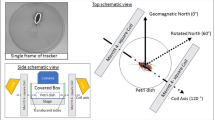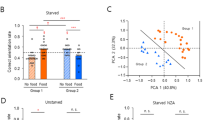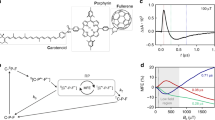Abstract
Over the past decade several investigators have provided convincing evidence that the orientation of pigeons and other birds during homing and migrational activities is significantly affected by Earth-strength (≤0.5 G) magnetic fields1–8. The presumed mediator of such effects would be a highly sensitive magnetore-ceptor which the birds would normally use to extract navigational information from the geomagnetic field. The recently reported measurement of magnetic remanence in honeybees9 and in homing pigeons10 has stimulated interest in the possibility that the magnetically sensitive structure may be constructed from permanently magnetic material. Here we report the detection of permanently magnetic material in the neck musculature of pigeons (Columba livia) and migratory white-crowned sparrows (Zonotrichia leucophrys). We propose that a magnetic field detector might involve the coupling of magnetic particles to a sensitive muscle receptor such as a spindle. A detection mechanism of this kind could account for the difficulties encountered in conditioning immobile homing pigeons to magnetic field changes11,12 and for the puzzling requirement of movement in other behavioural experiments involving pigeons and magnetic fields13,14.
This is a preview of subscription content, access via your institution
Access options
Subscribe to this journal
Receive 51 print issues and online access
$199.00 per year
only $3.90 per issue
Buy this article
- Purchase on Springer Link
- Instant access to full article PDF
Prices may be subject to local taxes which are calculated during checkout
Similar content being viewed by others
References
Keeton, W. T. Proc. natn. Acad. Sci. U.S.A. 68, 102–106 (1971).
Walcott, C. & Green, R. P. Science 184, 180–182 (1974).
Keeton, W. T., Larkin, T. S. & WIndsor, D. M. J. comp. Physiol. 95, 95–103 (1974).
Walcott, C. J. exp. Biol. 70, 105–123 (1977).
Walcott, C. in Animal Migration, Navigation, and Homing (eds Schmidt-Koenig, K. & Keeton, W. T.) 143–151 (Springer, Berlin, 1978).
Wiltschko, W. & Wiltschko, R. Science 176, 62–64 (1972).
Emlen, S. T., Wiltschko, W., Demong, N. J., Wiltschko, R. & Bergman, S. Science 193, 505–508 (1976).
Viehmann, W. Behaviour 68, 24–30 (1979).
Gould, J. L., Kirschvink, J. L. & Deffeyes, K. S. Science 201, 1026–1028 (1978).
Walcott, C., Gould, J. L. & Kirschvink, J. L. Science 205, 1027–1028 (1979).
Kreithen, M. L. & Keeton, W. T. J. comp. Physiol. 91, 355–362 (1974).
Beaugrand, J. P. J. comp. Physiol. 110, 343–355 (1976).
Bookman, M. A. Nature 267, 340–342 (1977).
Bookman, M. A. in Animal Migration, Navigation, and Homing (eds Schmidt-Koenig, K. & Keeton, W. T.) 127–134 (Springer-Berlin, 1978).
Goree, W. S. & Fuller, M. Rev. Geophys. Space Phys. 14, 591–608 (1976).
Butler, R. F. & Banerjee, S. K. J. geophys. Res. 80, 4049–4058 (1975).
Towe, K. M., Lowenstam, H. A. & Nesson, M. H. Science 142, 63–64 (1963).
Lowenstam, H.A. Science 156, 1373–1375 (1967).
Matthews, P. B. C. Physiol. Rev. 44, 219–288 (1964).
Barker, D. in Muscle Receptors, Handbook of Sensory Physiology Vol. III Part 2 (ed. Hunt, C. C.) 1–190 (Springer-Berlin, 1974).
Hunt, C. D. in Muscle Receptors, Handbook of Sensory Physiology Vol. III Part 2 (ed. Hunt, C. C.) 191–234 (Springer-Berlin, 1974).
Merton, D. A. Symp. Soc. exp. Biol. 18, 287–400 (1964).
Gelfan, S. & Carter, S. Exp. Neurol, 18, 469–473 (1967).
Goodwin, G. M., McCloskey, D. I. & Matthews, P. B. C. Science 175, 1382–1384 (1972).
Rocard, Y. in Biological Effects of Magnetic Fields (ed. Barnothy, M.F.) 279–286 (Plenum, New York, 1964).
Chadwick, D. G. & Jensen, L. Utah Water Res. Lab. Prog. Rep. 78–1 (1978).
Harvalik, Z. V. Physiol. Chem. Phys. 10, 525–534 (1978).
Williamson, T. New Scient. 81, 371–373 (1979).
Author information
Authors and Affiliations
Rights and permissions
About this article
Cite this article
Presti, D., Pettigrew, J. Ferromagnetic coupling to muscle receptors as a basis for geomagnetic field sensitivity in animals. Nature 285, 99–101 (1980). https://doi.org/10.1038/285099a0
Received:
Accepted:
Issue Date:
DOI: https://doi.org/10.1038/285099a0
This article is cited by
-
Numerical tests of magnetoreception models assisted with behavioral experiments on American cockroaches
Scientific Reports (2021)
-
Moderate strength (0.23–0.28 T) static magnetic fields (SMF) modulate signaling and differentiation in human embryonic cells
BMC Genomics (2009)
-
Visual but not trigeminal mediation of magnetic compass information in a migratory bird
Nature (2009)
-
Testing for the presence of magnetite in the upper-beak skin of homing pigeons
BioMetals (2007)
-
The physics and neurobiology of magnetoreception
Nature Reviews Neuroscience (2005)
Comments
By submitting a comment you agree to abide by our Terms and Community Guidelines. If you find something abusive or that does not comply with our terms or guidelines please flag it as inappropriate.



